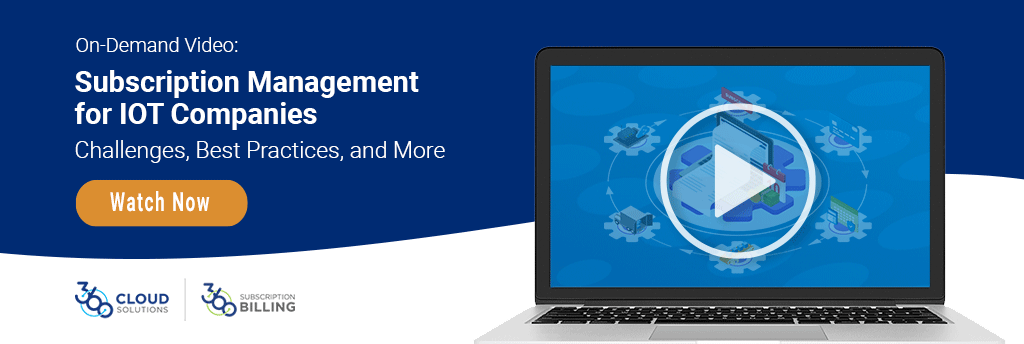As an Internet of Things (IoT) device manufacturer or reseller, it’s easy to assume that you should be putting your device at the center of your business model. After all, an IoT device is why you’re in business. But sometime after you ship that first device, it starts to become clear that the ongoing value of your business lies in your IoT subscription model.
There’s a reason that the subscription business model is so popular today. Subscriptions provide the sort of regular recurring revenue that makes a business attractive to investors. But if you’ve made the mistake of not implementing a subscription management system that can scale with your business – and your devices – then you’re not likely to see the revenue growth you might otherwise expect to achieve.
Benefits of an IoT subscription model
An IoT subscription model provides value for customers by delivering data-related services in concert with a device. The value of this model is around us everywhere in the consumer world and is becoming increasingly more advantageous for the business world as well.
For your business, this means a reliable recurring revenue stream and expanded opportunity to grow. Research from website conversion optimization company Invesp determined that it is five times more expensive to acquire a new customer than retain an existing customer. It’s also much easier to sell additional levels of service to an existing customer. According to Invesp’s research, a 5% boost to customer retention rates is reflected in profits by as much as 25% to 95%. This stable source of income can also give your company the support it needs to expand its customer base.
IoT companies have the added advantage of being able to collect data from their customer base. With more data accrued over time, device manufacturers can more effectively target future product updates while leveraging this data for retention.
Symptoms of the leading IoT business model mistake
Most IoT businesses begin with either a basic subscription management system in a spreadsheet or similar setup based upon a custom-developed system closely tied in with their device. The problems with this approach aren’t always evident at first. In the early stages, IoT businesses tend to focus on device sales, shipment, and service over subscription management.
Typically, the cracks in this model appear as your business begins to evolve and subscription models gain in complexity.
FREE GUIDE: For other common IoT business model pitfalls to avoid, check out our free guide, 5 Critical Mistakes that Limit Scaling and Growth.
Symptoms of this problem can include:
- An inability to provide complete historical data related to transactions. When a customer makes a change to their subscription level or service, do you have visibility into the complete life cycle of their subscription, or just history since the last billing period or significant change? Without this complete record, it becomes more difficult to appropriately manage renewals.
- More frequent customer complaints churn. If a long-time customer reaches out with a question about the terms of their subscription and related device(s), how quickly and accurately can you get to the answer? With basic subscription management tracking, organizations typically have information about the current state but can’t necessarily access a timeline of rate increases, discounts, device, or service level changes. If you’re not invested in your long-term customer relationship, it’s hard to keep those customers invested in you.
- Lost revenue through subscription billing errors and missed renewal opportunities. How easily and accurately are you tracking subscription renewals? As you adjust pricing, customers make changes to billing frequency, or subscription shifts to a new device, are you able to capture that information within the initial billing cycle? As subscription complexity increases, so too does the likelihood of errors in your subscription management system.
As you can see, the result of all of these symptoms is lost customers, lost revenue, and lost time and money spent tracking down new leaders rather than gaining value through customer retention.
Add value to devices with a subscription-centric model
The most effective solution to the challenges listed above is to implement business processes around an IoT subscription model. For some IoT companies, this may mean a shift in how the sales process is approached. Your IoT subscription model will emphasize the value of the data-driven service over the device itself. You’ll need a system that similarly puts the emphasis on tracking these valuable services.
An effective subscription management system is one that can provide information across the lifecycle of the subscription, not necessarily the device. After all, devices may go bad or be updated or shift to a new asset owner, so it’s important that your system be able to decouple service from a device as needed without losing valuable data. Automation is another key factor, as a system that can automatically update renewal information to account for changes to service or device is less likely to reflect billing errors.
Here at 360 Subscription Billing, we’ve diagnosed many IoT companies showing the symptoms listed above. The good news is that we’ve seen plenty of IoT innovators make a full recovery and go on to become leaders in customer service. The solution is a subscription billing solution that seamlessly integrates recurring billing management into your cloud-based ERP and/or CRM software suites. To learn more, we invite you to read some of our success stories or build a demo to see how 360 Subscription Billing can add value to your business.




